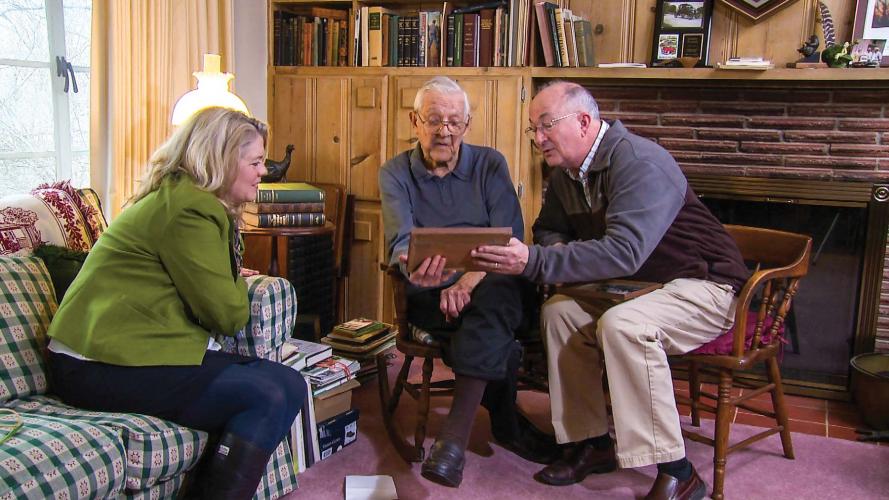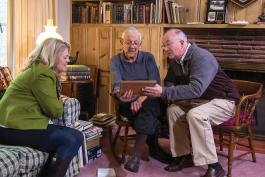There is something mystical about conversations that occur fireside, be it a fireplace or a campfire, that brings out the stories and storyteller in all of us. I witnessed it again this past February when, on a blustery day, Conservation Commissioner Dave Murphy and I had the great fortune to spend several hours chatting fireside with conservation giant and pioneer Bill T. Crawford. It was an unforgettable experience.
For those of us who know the Missouri conservation story well, we know there is only one living person from that historic meeting that started it all, and it is 99-year-old Crawford. He was the youngest attendee, only 17 years old at the time, when he accompanied his father to the September 1935 meeting at the Tiger Hotel in Columbia. More than 100 conservation leaders and sportsmen attended the meeting with one goal in
mind — to stop the downward spiral and exploitation of wildlife in Missouri.
Learning From the Past
It was a bleak story for conservation in the early 1930s. Missouri forests were decimated, wildlife was exploited by wagonloads to sell in markets, and streams carried more gravel than fish. Wildlife was at an all-time low with less than 2,000 deer and 3,500 wild turkeys. But, thankfully, the story didn’t end there.
Missouri citizens, especially sportsmen, came together at the Tiger Hotel to iron out a long-term solution. Crawford was there, and he is the final witness to the proceedings.
“My dad was one of the best quail hunters in town, so they picked solid people that liked the outdoors and were substantial citizens to come to the Tiger Hotel,” recounted Crawford. “I had never been in the Tiger Hotel before, but they had the best meeting room, and there were so many ideas there.”
The meeting hall echoed with the bold conversations that ensued, including direction to draft a constitutional amendment to form a four-person, nonpartisan Conservation Commission to restore Missouri’s wildlife and forests. Crawford witnessed not only the proceedings, buthe was there, too, along with many others, carrying petitions for the 1936 vote to establish the Conservation Commission.
“Dad had about 3,000 posters to put up, so we bought a 1935 Chevrolet car and drove all over the county putting up posters on telephone poles and post offices,” said Crawford. “We were early birds and there to help the cause.” The group’s hard work paid off in spades — Missouri citizens overwhelmingly supported Amendment 4, establishing the Missouri Department of Conservation.
But Crawford’s conservation story was just getting started. He took his love of wildlife and the outdoors, eventually studying biology at the University of Missouri-Columbia, and joined the department in 1942 to enhance the role of science in Missouri’s wildlife management efforts. It was pioneering work, starting from the ground up.
“Not much was known about the habitats of Missouri. We surveyed 20 square miles at a time to sample soil in 38 different areas, and we talked to a lot of farmers. When we talked about conservation, people could not even pronounce it. They called it conversation,” he laughed.
Crawford would eventually be in charge of the department biologists as the first wildlife research chief, a role he held until his retirement in 1983. Crawford is also credited with creating the Missouri Natural Areas Program and co-founding the Missouri Prairie Foundation. Crawford was awarded the Master Conservationist Award in 2010, which is the highest honor the department can bestow on citizens who have accomplished exemplary conservation work.
Looking to the Future
While Crawford is an invaluable connection to our past, he also embodies our conservation future. As I look ahead to what’s on the horizon, I see citizens still gathering in the name of conservation to make a difference. I see science still at the heart of our mission.
I see partnerships still thriving. I also see how the forward-thinking ideas of concerned citizens years ago gifted us with the foundation to successfully conserve the fish, forest, and wildlife resources today.
It is a much brighter picture in 2017. We have abundant wildlife, thriving state forests, healthy wetlands, wildlife and aquatic research, nearly 1,000 conservation areas, stream accesses, a robust hatchery system, effective wildlife law enforcement, and innovative conservation education programs. While we also have many big conservation challenges ahead, those ideas first voiced at the Tiger Hotel 80 years ago give us the solid foundation to tackle them head-on.
I’m thankful we still have conservation pioneers like Bill Crawford to share our story and cheer us on.
80 Years of Conservation
Bill Crawford was instrumental in developing the Natural Areas System, established in 1977, which became a model for the protection of original landscapes. To hear Crawford retell his role in Missouri’s conservation history, watch his interview with our partners at the Conservation Federation of Missouri at youtu.be/FM8Bk2MG1g4.
Timeline of Conservation Events
Celebrating 80 years of serving nature and you!
- Sept. 10, 1935 - Nearly 100 sportsmen meet at the Tiger Hotel in Columbia to discuss depleting wildlife resources in Missouri. The Conservation Federation of Missouri is established.
- Nov. 3, 1936 - Missouri voters approve Amendment 4 by a margin of 71-29 percent, creating a state nonpartisan conservation agency with exclusive authority over fish, forests, and wildlife.
- July 1, 1937 - The constitutional amendment creating the Missouri Conservation Commission takes effect.
- 1938 - Deer and turkey seasons are closed statewide due to limited numbers. Only about 2,500 turkeys and 1,800 deer remained in the state.
- July 1938 - First issue of the Missouri Conservationist is published.
- 1944 - A bucks-only deer season reopens in 20 counties.
- 1946 - The department begins intensive efforts to restore more than 112,000 wetland acres. First bow season opens in Crawford County for three days. Eighty archers participated. It wasn’t until 1952 that a deer would be harvested with a bow.
- August 1947 - A special-use permit is signed with the Forest Service, acquiring full use of the state forest nursery. Today more than 3 million tree seedlings are produced each year.
- 1957 - Missouri’s first formal hunter safety training begins as a voluntary course.
- 1959 - Deer season reopens in all Missouri counties. Shepherd of the Hills Hatchery begins operations.
- 1960 - Missouri’s spring turkey season reopens across the state.
- 1969 - The first community forester is hired in Kansas City to provide assistance on community tree management. Urban fishing program begins in St. Louis City park lakes, the first in the nation.
- 1973 - The first staffed range, August A. Busch Shooting Range, opens in St. Louis.
- 1975 - Fall archery season for turkey reopens.
- 1976 - Missouri voters approve the Design for Conservation sales tax. The one-eighth of 1 percent sales tax provides dedicated funding for the conservation of fish, forests, and wildlife.
- 1978 - First fall firearms season for turkey.
- 1982 - The first conservation nature center, Burr Oak Woods in Blue Springs, is built.
- 1987 - The Conservation Commission approves a mandatory hunter education requirement for all hunters during the firearms season beginning in 1988.
- 1989 - Missouri Stream Team program is established
- 1990 - Rural firefighter property center is acquired.
- 2001 - First youth-only, two-day spring turkey season and youth-only portion of the firearms deer hunting season are established
- 2011 - Elk are reintroduced in Carter, Shannon, and Reynolds counties. Wild elk, formerly abundant in the state, had not been seen in Missouri since 1865.
- 2006 - The department develops Discover Nature Schools program, free science-based curriculum materials for grades pre-school–12.




And More...
This Issue's Staff
Art Director - Cliff White
Associate Editor - Bonnie Chasteen
Staff Writer - Heather Feeler
Staff Writer - Kristie Hilgedick
Staff Writer - Joe Jerek
Photographer - Noppadol Paothong
Photographer - David Stonner
Designer - Les Fortenberry
Designer - Marci Porter
Designer - Stephanie Thurber
Circulation - Laura Scheuler






















